It sounds like you're encountering a common issue when working with AJAX POST requests in a Shopify app. The 400 Bad Request error typically indicates that there's something wrong with the request format or the way the server is interpreting it. Here are a few steps and considerations that might help you resolve this problem:
1. Ensure Proper Configuration of Proxy URL
- Make sure that your proxy URL is correctly configured in your Shopify app settings. The proxy URL should match the path you've specified (apps/member).
2. Validate AJAX Request Format
- Ensure that your AJAX request is properly formatted and includes the necessary headers, especially if Shopify expects certain headers for authentication or content type.
3. Verify CSRF Tokens
Shopify might require CSRF tokens to be included in your AJAX requests for security purposes. Ensure your request includes the necessary CSRF tokens.
4. Check Server-Side Handling
- Make sure your server-side code correctly handles the POST request and that the endpoint is correctly defined.
Here’s an example of how you might structure your AJAX call and server-side code:
AJAX Request
javascript
$.ajax({
url: '/apps/member/your-endpoint',
type: 'POST',
contentType: 'application/json',
data: JSON.stringify({
// your data here
key1: value1,
key2: value2
}),
success: function(response) {
console.log('Success:', response);
},
error: function(xhr, status, error) {
console.log('Error:', error);
}
});
Razor Page (.cshtml)
Ensure your Razor view is set up to include any necessary tokens and scripts.
html
@page
@model YourPageModel
@{
ViewData["Title"] = "Your Page Title";
}
<!DOCTYPE html>
<html>
<head>
<title>@ViewData["Title"]</title>
</head>
<body>
<form id="your-form">
<!-- form fields -->
</form>
<script src="https://code.jquery.com/jquery-3.6.0.min.js"></script>
<script>
// Your AJAX call here
</script>
</body>
</html>
Razor Page Model (.cshtml.cs)
Handle the POST request in your code-behind file.
csharp
using Microsoft.AspNetCore.Mvc;
using Microsoft.AspNetCore.Mvc.RazorPages;
public class YourPageModel : PageModel
{
[BindProperty]
public string Key1 { get; set; }
[BindProperty]
public string Key2 { get; set; }
public IActionResult OnPost()
{
// Handle the data here
if (!ModelState.IsValid)
{
return BadRequest(ModelState);
}
// Process data
return new JsonResult(new { success = true });
}
}
5. Debugging Tips
- Check Browser Console: Look at the browser console for more detailed error messages.
- Inspect Network Traffic: Use browser developer tools to inspect the network traffic and ensure the request is formatted correctly.
- Log Server-Side Errors: Add logging to your server-side code to capture detailed error information.
6. Shopify App Proxy Specifics
- Ensure your app proxy setup in Shopify is correctly pointing to your app and that your app is correctly configured to handle the requests.
Example Proxy Setup in Shopify Admin
- Go to your app in the Shopify admin.
- Navigate to the App proxy section.
- Set the Subpath prefix to apps.
- Set the Subpath to member.
- Set the Proxy URL to your app's URL endpoint.
Troubleshooting Common Issues
CORS Issues: Ensure your server is properly configured to handle CORS if necessary.
Content-Type: Make sure the contentType in your AJAX request matches what your server expects (application/json is common).
Authentication: Verify that any required authentication tokens or headers are included in your request.
By following these steps and ensuring all configurations are correct, you should be able to resolve the 400 Bad Request error. If the issue persists, provide detailed logs or error messages for further assistance.
Conclusion
When facing a 400 Bad Request error with AJAX POST requests in a Shopify app, it’s crucial to methodically verify each aspect of your setup. Ensure your proxy URL is accurately configured, your AJAX requests are correctly formatted, and your server-side code properly handles the incoming data. Pay close attention to required headers, CSRF tokens, and content types. Debugging tools like browser consoles and network inspectors can provide valuable insights into request formatting and server responses. By addressing these elements and ensuring alignment between Shopify’s expectations and your app’s configuration, you can resolve the issue and ensure smooth communication between your app and Shopify.
For additional assistance with Shopify-related queries, consider reaching out to Shopify E-commerce development experts at SDLC Corp.



















